
A million words must have been written over the decades about this issue of X-MEN, the conclusion to the Dark Phoenix Saga and the high point of the fabled Chris Claremont and John Byrne run. And in the shadow of what would follow in the years to come, perhaps the book has lost some of its luster–I could write a whole treatise on how the decision to bring Jean Grey back to life for the launch of X-FACTOR was one of the fundamental missteps that changed the entire trajectory of the Marvel Universe moving forward. But I’m here today to speak about this particular story as a reader, because I bought this issue in real time, on the day it came out, and it was exactly as amazing and mind-blowing as its been made out to be.

I’ve talked previously about how it’s impossible to set out to pitch a perfect game, to make a quintessential comic–all everybody does each time out is their best, and sometimes the zeitgeist just comes together to produce magic. X-MEN #137 is the opposite of that–it’s the perfect game that’s only a perfect game by accident, and the kind of editorial interference and last-minute story-rearranging that went on in its pages should have resulted in a conclusion that was a bloody awful mess rather than the high water mark for the series. In this way, writer Chris Claremont, co-plotter and penciler John Byrne and Editor in Chief Jim Shooter beat the odds in a way that I don’t believe has ever been equaled before or since.
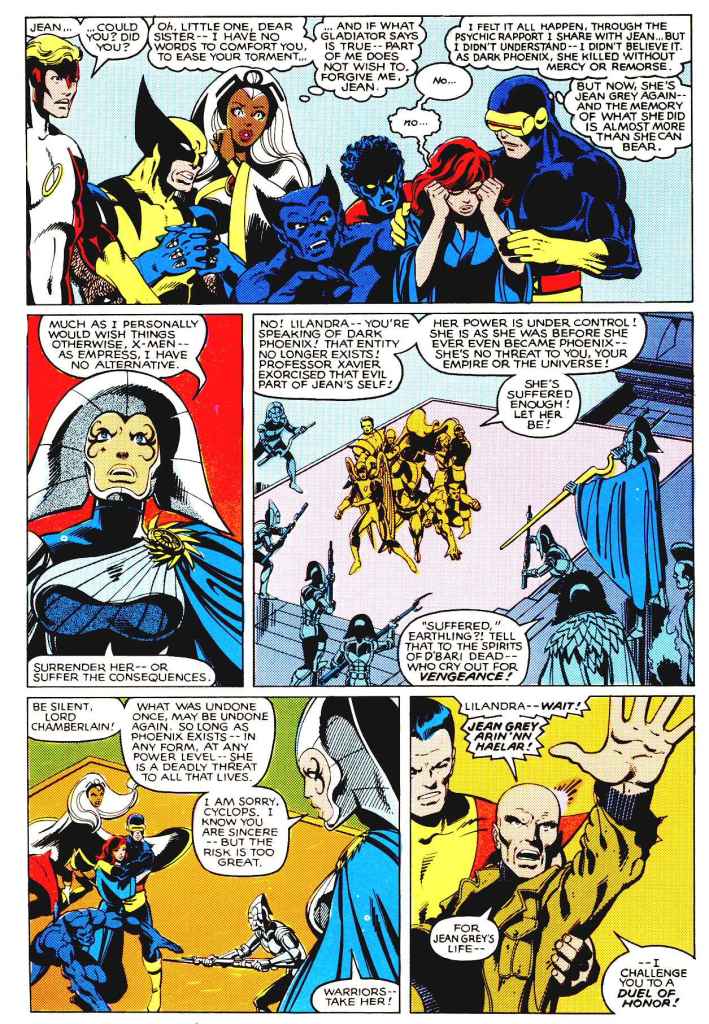
Some quick backstory here to set the stage. Upon reinventing the X-Men beginning in 1975, both Claremont and his artist of the period, Dave Cockrum, realized that they wanted to keep Jean Grey in the fold, but that the character needed a major upgrade–she was simply too wimpy and ineffectual as Marvel Girl. So they transformed Jean into Phoenix by bombarding her with cosmic rays and having her die and be reborn. Phoenix was hella powerful–so powerful in Claremont’s hands that, in the opinion of incoming artist John Byrne, she made the rest of the team superfluous. And so, the two creators came up with a storyline in which Jean would be seduced by the evil illusionist Mastermind, would succumb to the dark side and become a full-on villain, and would ultimately be stripped of her cosmic powers and returned to being regular Jean Grey (or a Jean with the mind of a child, or a few other possibilities–Claremont and Byrne both had different ideas. and nothing ever quite got resolved.)
That Dark Phoenix storyline was incredibly good–it was the must-read story of that period, where the drama and the stakes were at their maximum, and both creators were doing outstanding work. The problem came, though, a few issues from the end. Having become drunk on her unlimited telekinetic power, Byrne had Phoenix consume a sun, killing an entire populated planet. On top of that, she wipes out the Shi’ar starship that tries to prevent this from happening. When EIC Jim Shooter found out about this and the eventual plans for the resolution to the storyline, he hit the roof. This was 1980, and in those days, super heroes didn’t kill (Jim even decided in this period that Wolverine had never taken a life before, causing Claremont to have to bring back some guys Logan had sliced up in an earlier issue as cyborgs.)
Jim was insistent that Jean had t pay for her crimes, that she couldn’t just get a metaphoric slap on the wrist and be sent back to Earth to be an X-Man again. Claremont and Byrne argued their respective positions–Claremont in particular rejected any thought of incarcerating Jean, saying that the X-Men as he understood them would never stand for such a thing, and so every story would be about them trying to break her out of prison. Ultimately, the decision that everybody backed their way into was to kill Jean off, to have her pay the ultimate price for her misdeeds. This was a pretty bold thing to do. You have to understand, at this moment in the series history, the Scott/Jean romance was the centerpoint of the series. The newcomer X-Men like Wolverine and Storm had been growing in popularity all along, but Scott and Jean were the hub around which everything revolved. And Jean was an original Stan Lee/Jack Kirby 1960s creation–those felt as though they were somehow sacrosanct. and yet, with no other avenue open to them, everybody involved made the decision to bite the bullet and have Jean bite the big one.
I ought to mention how late in the game this change happened. #135 was about to be in stores. #137 was all finished and ready to go to print, and #138 was completely penciled. What’s more, #137 was a double-sized anniversary issue, and the orders on it in the increasingly-important Direct Market were strong enough that breaking it in half and turning it into two regular sized issues wasn’t an option. Byrne and his inker Terry Austin were fast enough, though, to do five or six new pages and only have the book ship a week late. So that’s where the substantial changes were made–stripping off the entirety of the original final chapter of what had been a three-chapter story and substituting a new ending in which Jean became Phoenix again and then killed herself rather than go on that way. Additionally, though, Claremont took the opportunity that week to go back through the rest of the issue and heavily re-dialogue certain sequences to address some of Shooter’s concerns: namely, that the X-Men don’t appear to be at all conflicted about fighting on behalf of somebody who has just murdered an entire planet of intelligent beings. So Chris took sequences that were simply about the X-Men thinking about their individual ongoing plotlines and soap opera and instead made them all about the characters grappling with the reality of what Jean had done. Without these changes, even with the new ending, I suspect the final product would have felt lightweight. I’ve spotlighted a few of the page after-and-before up above.

Apart from all of the emotional turmoil, this is also a hell of a fun action comic, with an extended battle on the surface of the moon (inside the Blue Area that has an atmosphere, of course) between the X-Men and the Shi’ar Imperial Guard for the fate of Jean and the Phoenix. It’s full of cool, colorful characters and energetic battle sequences–Byrne’s fight choreography was the equal of anyone’s at this point in his career, and he juggles the massive number of combatants on both sides effortlessly. And as was his wont, Claremont would work in beats of characterization and revelation between the punches and zaps–his fight sequences were laden with revelations about the people fighting, and wound up being about much more than whatever the surface stakes of the battle seemed to be about. As an artistic combination, Byrne and Austin were the pinnacle in 1980, so the series was about the best-looking thing on the stands at the time. It’s worth remembering that at this moment, X-MEN had not yet become the huge sales juggernaut that it would be–this storyline was what really started to put it over the top in that regard. But among hardcore fans, of the kind who frequented the growing number of early comic book stores, it was already a wildly popular series.
And for all that it was the result of argument and uneasy compromise and thrust and parley, the version of X-MEN #137 is a much better, much more memorable story than what would have reached the racks otherwise. That version of the book would have been fine, but it wouldn’t have struck the emotional nerve that Jean’s last stand and ultimate decision did. Because make no mistake about it, the audience reading X-MEN was deeply invested in that character and that relationship–and the thought that she would be killed off was so unthinkable that when it happened it was as though an actual person that you knew had died. I can remember getting to the climax of this issue and simply being stunned by it for a few minutes. And yet, it all seemed natural, it all felt as though this had been the plan right from the first. Every note lands, every beat is right, and the ending is both cathartic in the manner of a climax while also being sad and downbeat. It really is the Empire Strikes Back of comic books in that regard. People hated the outcome, but they also wanted to read the comic again. It was operatic, the first true tragedy in comic book form. It toppled the Death of Gwen Stacy as the most affecting demise in the history of the medium up to that point.
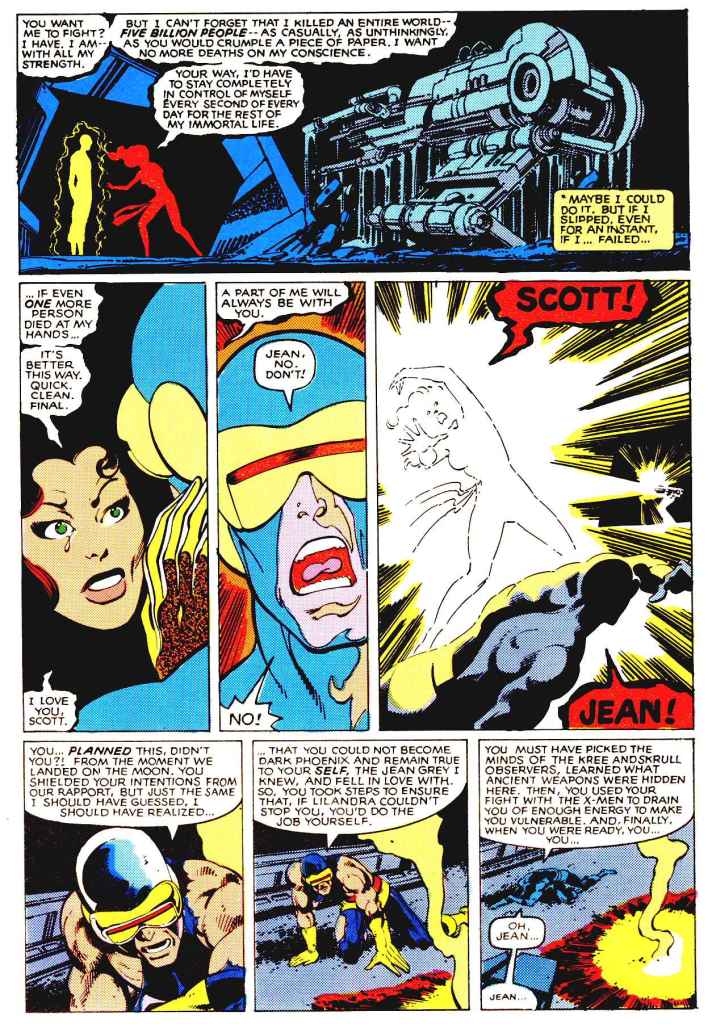
I don’t know quite what that says for the question of editorial interference in the making of comic book stories. Certainly, the way this issue came together is no formula for how to do it–it’s a frankly astonishing achievement that the result is as memorable as it is. By that same token, it does illustrate the positive side of editorial feedback, as without Shooter having made an issue of the fact that Dark Phoenix had committed mass murder, Claremont and Byrne would not have focused the efforts of their story on trying to grapple with that fact. Its birthing was chaotic and traumatic, and not a bit of fun for any of the principles involved. But the end result of all that blood and sweat and tears and anguish was a perfect game.
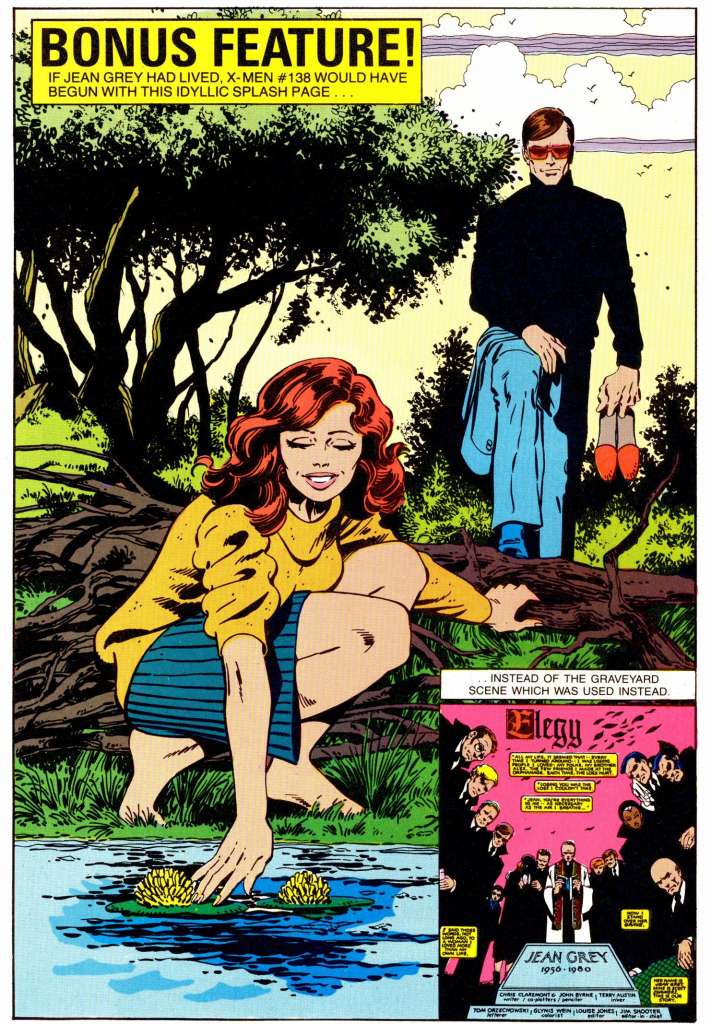


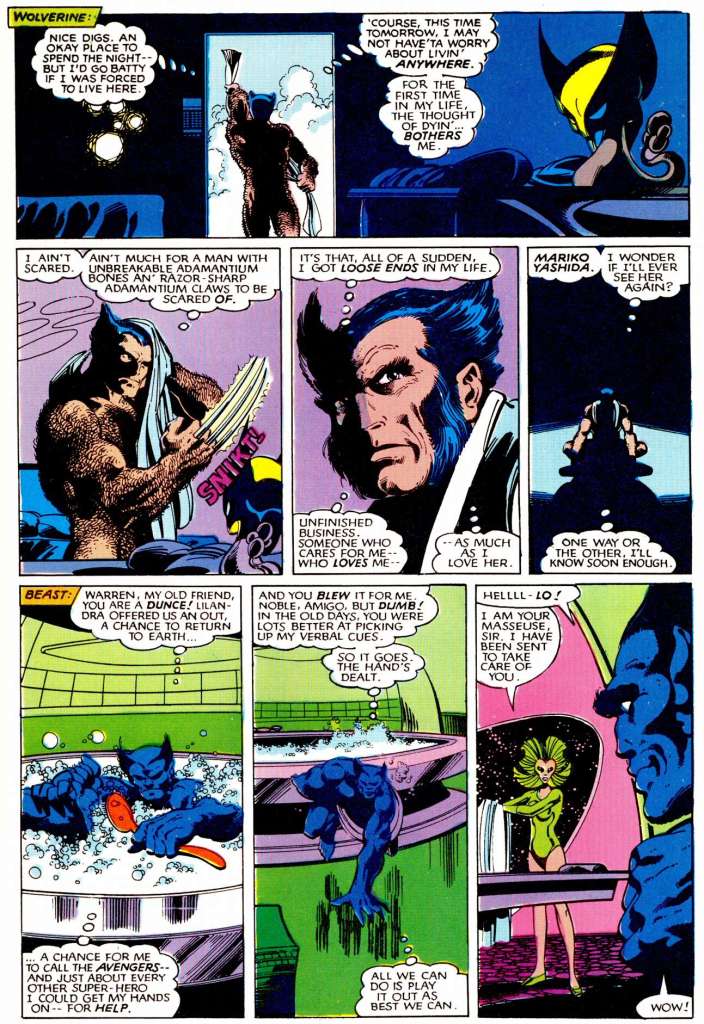

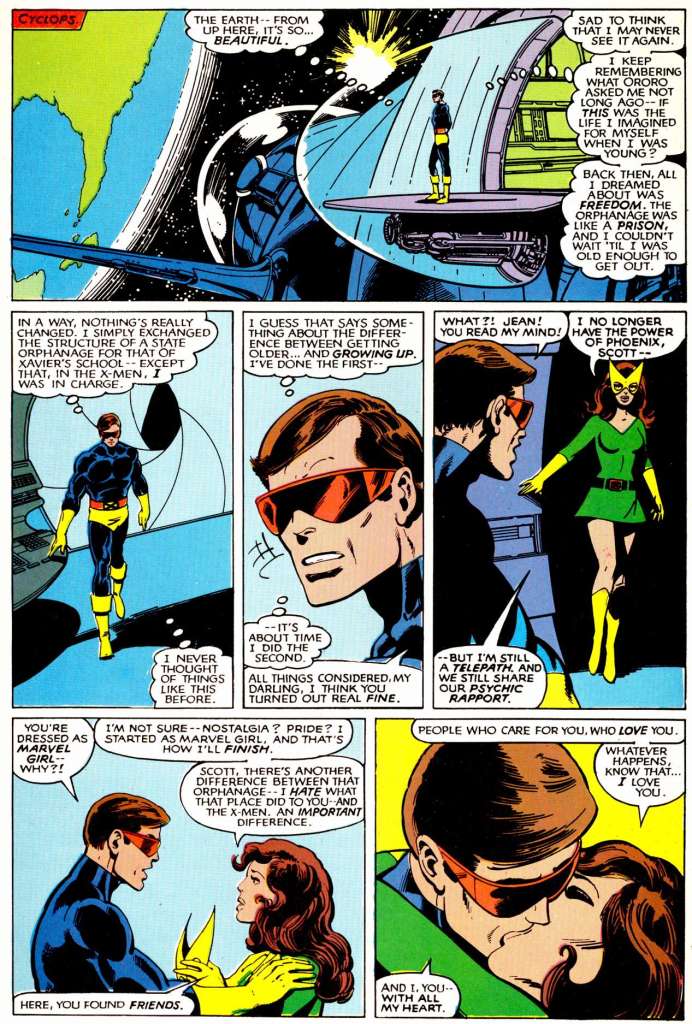
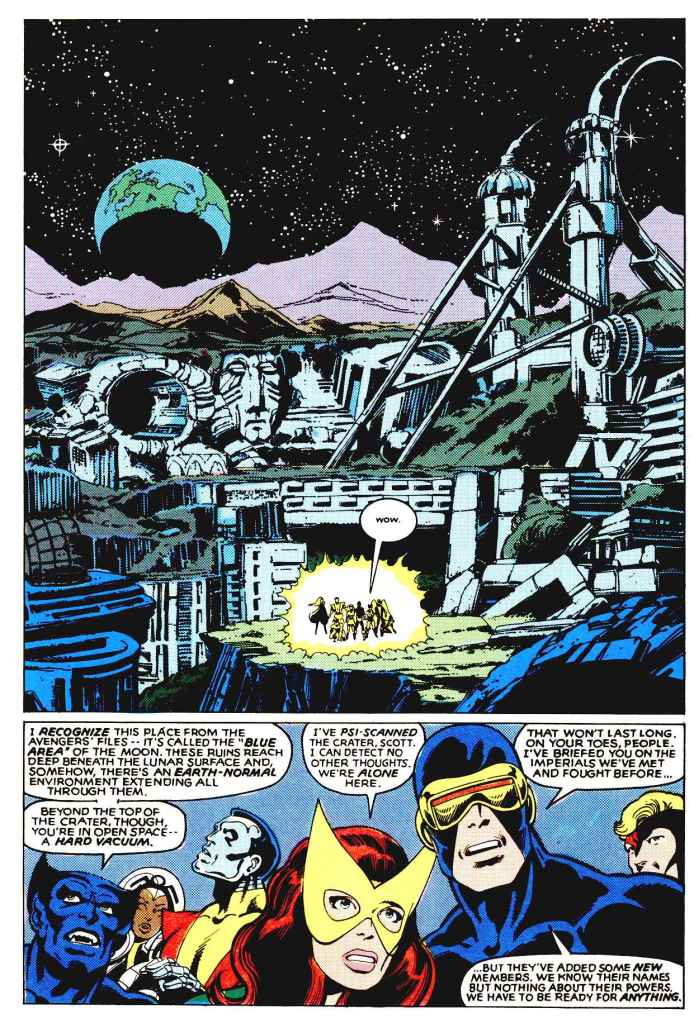
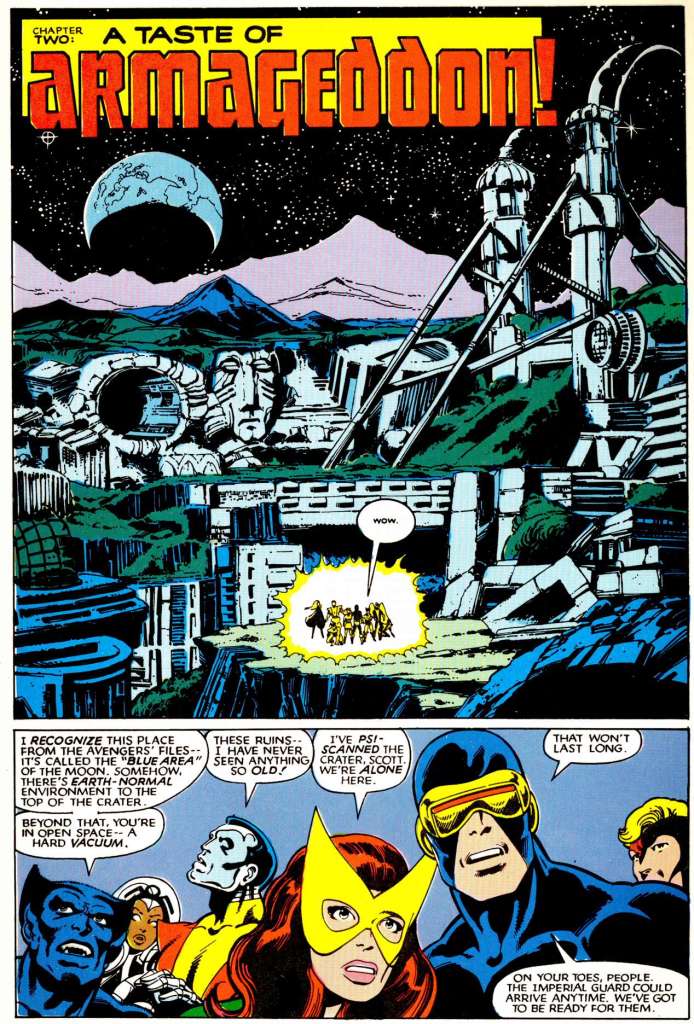
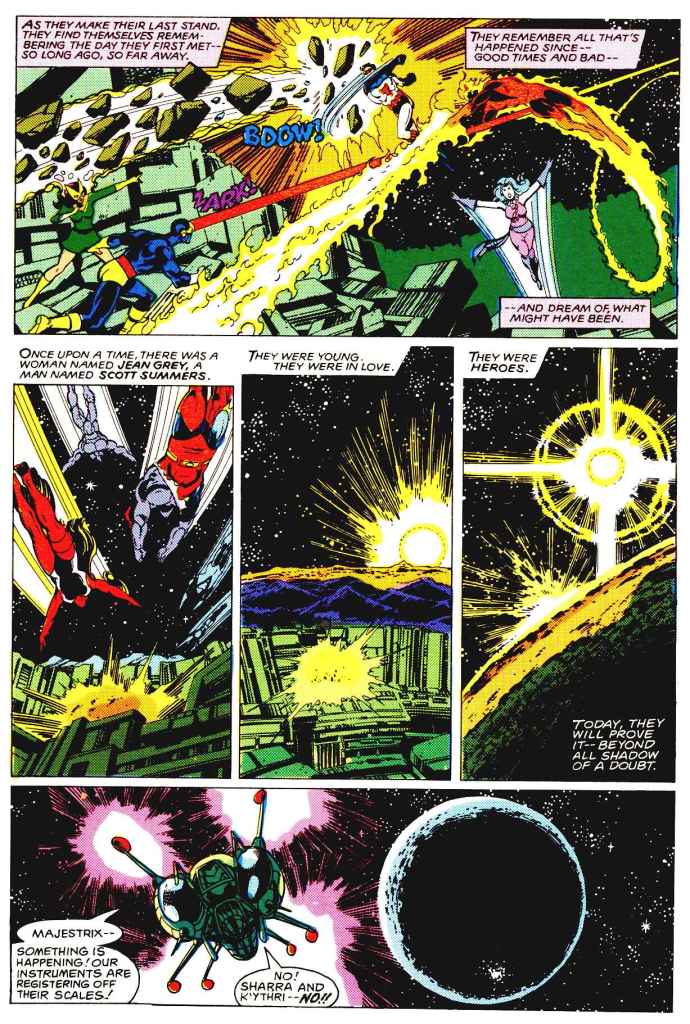

Great moments in comic book history. Though I tend to agree with some articles sugfesting the 3 final panels of Scott’s despair over Jean were overly wordy. Some if the exposition could have veen cut, giving his grief more room to breathe.
But it was 40 years ago, in the thick of the Bronze Age. Only so much innovation was possible. And it was about as innovative as it could be, at that time.
LikeLiked by 1 person
I was blown away by this issue when it came out. Claremont, Byrne and Austin could do no wrong. The issues with the Hellfire Club, Mastermind, and the introduction of the White Queen were brilliant. This series was so very exciting.
LikeLike
The saying goes that a good editor helps make a good writer great. In this case, a great writer and artist. Shooter did his job — pushed creators to examine the consequences of their characters’ actions. The entire saga — not just this issue or five that immediately preceded it, but the entire storyline that played out over a few years — was phenomenal and Shooter forced Claremont and Byrne to hit the landing perfectly.
LikeLike
Good article, yes. But i like very much the fact you mention Jean’s being overwhelmed by her power and unable to resist the need to use it . That was the most original part of her own dillema, at the time and made her go through the likes of a drugg-addict, changing her from a sweet noble character into a desperate and lost one, anable to cope with her human feelings anymore, so futiles compared to what she had become. I DO HATE the schyzophrenic Jekill & Hide way the whole thing has been turned into later in the Comic book: so much less original and interesting.
LikeLike
👍
LikeLike
It was the first time I shed tears over the death of a character. I never thought it be from the X-men. There has been nothing to surpass this story to date.
LikeLiked by 1 person